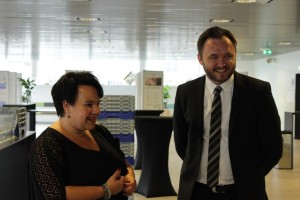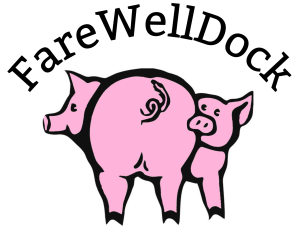On 29 – 30 April 2015 Danish Minister for Food, Agriculture and Fisheries, Dan Jørgensen hosted an international conference “Improving Pig Welfare – what are the ways forward?“.
During the two-day conference, top academics, experts and political stakeholders from around the world debated and worked to prepare the way forward in improving pig welfare in Europe and ultimately in the world.
Below are ‘soundbites’ from video-interviews with legislators attending the conference, all more or less related to the subjects of study in the FareWellDock project.
A pig is an intelligent animal. It is a sentient being. Therefore, it needs to be treated with respect (Dan Jørgensen, Danish Minister for Food, Agriculture and Fisheries)
Finding solutions in how we can produce pigs in a competive manner, but at the same time improve the animal welfare, is an extremely important task (D. Jørgensen)

To the left: Sharon Dijksma, Minister for Agriculture, NL. To the right: Dan Jørgensen, Minister for Food, Agriculture and Fisheries, DK
Sharon Dijksma, Minister for Agriculture, The Netherlands – “Towards Sustainable Pig Farming – The Dutch Way”
Dutch pigs are top quality animals: they are healthy, fertile and, if I may say so, good to eat (S. Dijksma)
Pig welfare is playing a growing role in where the Dutch pig industry is at present (S. Dijksma).
The Dutch care deeply about animal welfare. Animals have intrinsic value, i.e. value in itself, independent of people (S. Dijksma).
We are happy other countries share our conviction. Together we will be more succesful convincing the agricultural sector worldwide to put the welfare of animals first (S. Dijksma).
We must respect the animals’ physical integrity. … Physical integrity also means letting pigs keep their tails (S. Dijksma).
I call on the sector to make every effort to prevent tail biting as much as possible…. My aim is a complete ban on tail docking (S. Dijksma).
Animal welfare also means animals must be able to exhibit their natural behaviour. Pigs investigate their environment by rooting and biting. (S. Dijksma)
When we eat meat it is good to know that the animals from which our meat derives have had a pleasant life (S. Dijksma)
I’m convinced that nothing beats the taste of pork chops of a pig that really lived well (S. Dijksma)
It is wrong to put farmers in the bank of the accused ones (Christian Schmidt, Federal Minister of Food and Agriculture, Germany – “Minding Animals – Ways to Improve Animal Welfare“)
Sven-Erik Bucht, Minister for Rural Affairs, Sweden – “High Animal Welfare – A Winning Concept for Future Pig Production”
We are what we eat (S.-E. Bucht)
[In EU pig production] We must focus on quality, and quality means animal welfare (S.-E. Bucht)
Good animal welfare is not about the health and well-being of our pigs. It is also about our own health, and of our children, and of our grandchildren (S.-E. Bucht)
About truely good food, we all have a lot to learn (S.-E. Bucht)
More and more the European consumer calls for animal-friendly products (Denis Simonin, Policy officer on animal welfare at European Commission)
The EU strategy for the protection and welfare of animals (2012-2015) was focused on the enforcement of the EU rules (D. Simonin)
Almost 2/3 of member states are fully compliant with welfare regulations on group housing of sows
(D. Simonin)
[In the European Commission] Work is still ongoing on the development of guidelines aiming to achieve better implementation of the use of manipulable materials (D. Simonin)
EU reference centers for animal welfare to support the enforcement of animal welfare standards
(D. Simonin)
Problems with the treatment of pigs are among the most important problems to be improved as regards animal welfare (Janusz Wojciechowski, MEP and Vice-chairman in the Committee on Agriculture and Rural Development)
Pigs are very intelligent and very sensitive (J. Wojciechowski)
Esp. European pig farming is increasingly industrialised. Thousands of pigs in one place is not good for animal welfare standards (J. Wojciechowski)














